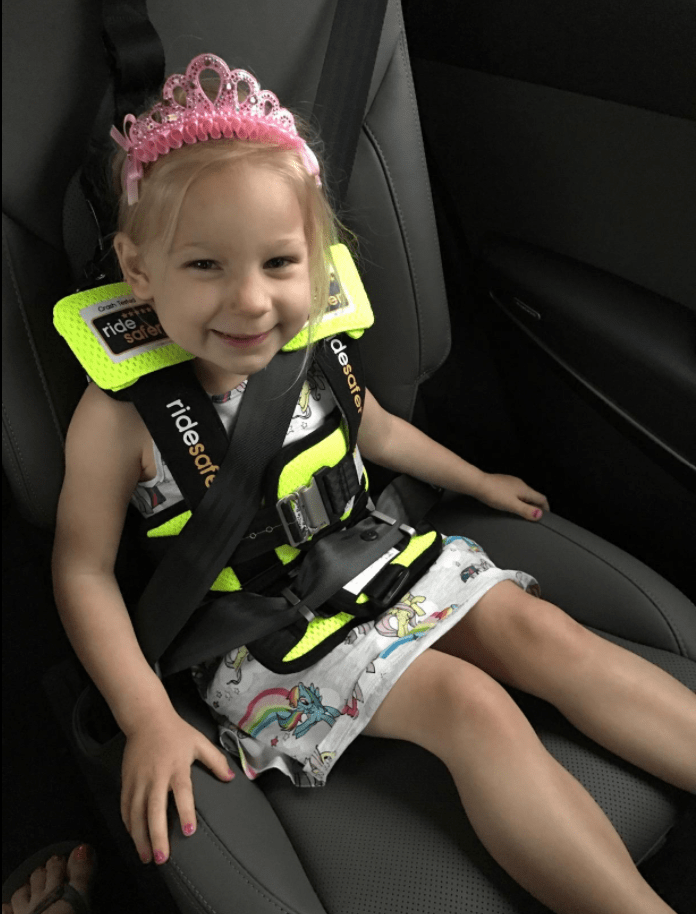
Last Updated: .
FYI: We are Baby Bargains, the #1 online source for independent, reader-supported reviews of baby gear. We don't take money from the brands we review: no freebies, no sponsorships.
Best 3 Across Car Seats
We evaluated and tested 27 different car seats for carpools and multiples before coming up with the Best 3 Across Car Seats. Here are our picks for best bets for infants, toddlers and older children.
The best car seat for carpools (or multiples) must be a jack of all trades—narrow enough to fit three seats across in the backseat of an average-size vehicle, easy to install by kids themselves (assuming you’re transporting older kids, not infants) and light enough to easily move from vehicle to vehicle.
First, we’ll look at the options for older kids who are booster seat age, since carpools are most common here. We’ll also touch on the best bets 3-across seats for toddlers and infants, focusing on which seats are narrow enough to fit in a back seat (or you can use a combination of seats for three younger/older siblings). Let’s go!
Best Carpool Car Seat for Kids Age 5 & Up
Check on Amazon
Best Carpool Car Seat for Kids Age 5 & Up
The Rider Safer Travel Vest by Safe Travel Systems by Safe Traffic System is our top pick for an easy to use and portable solution for carpoolers. No bulky seats, no complex belt-paths—the vest positions the vehicle shoulder and lap belts to correctly fit a child 30 to 80 lbs. (our recommendation is ages five and up, which we will explain shortly).
The travel vest comes in two sizes: small (age range 3-6 years, 30-60 lbs) and large (age range 5 to 8 years, 50-80 lbs). Here’s what it looks like when installed:
So you might be wondering—is this thing safe? The answer is yes: the vest is tested to the same standards as regular car seats and has passed. The maker (Safe Travel System) has a 15-year track record in this category and must crash test all its products to the same federal car seat standard (FMVSS213) that all car seats must meet.
We tested the Ride Safer Travel Vest and found it was an excellent solution for carpools, especially for kids age five and up. It is lightweight and easily fits in a backpack.
FYI: There is another version of the travel vest (called the Travel Vest 3) that is about fifteen bucks cheaper but we found it to be inferior—that’s because you can only use it in vehicles with a lap and shoulder belt. The Vest 2 can be used with just the lap belt and a tether strap
Flaws but not deal breakers
Teaching a child how to thread the seat belt through the Travel Vest can be a challenge—that’s why this solution is probably best for kiddos age five and up. Also: younger kids may not sit properly in the Travel Vest (slumping over, etc) and that could compromise its safety. Yes, the manufacturer says you can use the Travel Vest for three years and up, but we think it is best for children ages five and up.
Best 3-Across Booster Seat
Check on Amazon
Best 3 Across Booster seats for older kiddos: Mifold
The Mifold bills itself as the “grab and go” booster and that is just about right—it basically is a foldable booster seat that works for kids age 4 and up, 40 to 100 lbs. and 40 to 57″ tall.
When folded, the Mifold is just 10″ x 5″ x 2″—and that makes stashing it in a backpack or carry-on easy.
When open, the Mifold looks like this:
In our testing, we found the Mifold incredibly easy to use—it’s very narrow profile enables three across in just about every vehicle. Our testers said it was easy to thread the lap belt through the guides; and the stealth-like look makes the Mifold a good choice in case your kiddo is protesting the “baby seat” thing.
Flaws but not deal breakers
So what’s not to like? The shoulder belt can be a bit tricky to adjust—it will require some practice. And the narrow and thin profile does have another disadvantage: it doesn’t really “boost” kids, so that means seeing out the window in some vehicles may be difficult.
The Mifold doesn’t have any leg support, so that also may limit comfort on longer trips.
Despite these negatives, the Mifold is our pick as the best 3 Across Booster Car Seat for carpools, trips and other outings where lugging around a large booster car seat isn’t practical.
Also Great: BumbleBum
BubbleBum is an affordable, inflatable, backless booster seat invented by a certified car seat tech from Northern Ireland (it’s been available in the UK for quite a while). The idea was to have an easy-to-carry booster seat option for travel, rental cars, etc. But it’s also a great option if you live in a place like New York and need a portable option for Uber.
Another plus: it’s cheap. But does it work well? Car seat techs report that the BubbleBum does provide good lap and shoulder belt fit (the IIHS gave it a “Best Bet” rating). The seat belt is threaded through a lap belt positioner, which keeps the belt in the proper position.
Critics note it can be confusing to use the positioner at first. Techs recommend threading the seat belt through the positioner after you have buckled your child into the seat to get a tighter fit—it’s hard for a child to do this by herself. That means you (the parent) will be doing this and that isn’t fun in a hot rental car or for frequent stops.
FYI: BumbleBum revised the belt positioner in mid 2015 to be easier to use; most of the complaints we see on the Bumblebum are for the old adjuster.
Also: keep in mind the BumbleBum is a small seat and doesn’t provide much thigh support. So the BumbleBum isn’t going to be comfortable for long-term use. On the plus side, however, the small size of the seat makes it possible to use it in a three-across situation.
Most readers are happy with the Bumblebum, despite these drawbacks. We like the BumbleBum for its portability, price and safety. When used for short-term situations and travel, it’s a great option.
Best Foldable Booster Seat
Check on Amazon
Also Great: Diono 3RXT
The Radian 3RXT is Diono’s flagship car seat that boasts three key advantages: extended harness use (up to 80 lbs.), a narrow base and a seat that is car pool friendly—yes, they fold up! The Radian accomplishes its folding trick by omitting the base you see on so many convertible seats—the seat actually sits along the back of the vehicle’s seat.
One plus to this: the Radian’s narrow base allows for a three-across install in the back of a vehicle. The Radian now comes in three versions: 3RXT, 3RX and 3R. All the seats feature steel alloy frames. And you can use LATCH up to 80 lbs. (65 lbs. for the R100), much higher than other seats on the market.
Our favorite is the 3RXT. It features a special trick: the harness removes so the seat can become a belt positioning booster (up to 120 lbs.). The pitch: you can use this from birth (starting at 5 lbs.), rear-facing for infants, forward-facing for toddlers with a harness that works to 80 lbs. . . . and then in belt-positioning mode to 120 lbs.
The RXT also features memory foam and side impact protection (wings that are near the top of the seat). Reader feedback on the Diono Radian has generally been positive. Folks love the narrow, low profile of the seats and their overall quality.
Yes, you can fit three of these in a back seat in most vehicles, which is difficult with many other seats. Here’s what that looks like:
What’s not to like? Well, these seats are rather tall and that can make the fit rear-facing difficult in smaller vehicles. Even though these seats fold up, they are rather heavy (25+ pounds)—so lugging them around is no picnic.
And ease of use is a problem: Diono bombed on the government’s ease of use ratings, earning very low scores. Consumer Reports echoed that issue, citing “fair” ease of use and rear-facing fit to vehicle. The Diono Radian ranked at the bottom of CR’s “all-in-one” seat tests. Not encouraging.
One reason for the ease of use ratings for these seats: the numerous installation options and features of these seats can take a while to learn.
On the plus side, the Insurance Institute for Highway Safety rates the Radian (R100, R120 and RXT) to be a “best bet” in booster mode. Bottom line: these seats are best for folks who need a seat to fit a super-size baby—or need to put three seats across in a back seat.
There are few other seats on the market that are as narrow (in the base) as the Radians. Yet the steep learning curve for this seat with all its various features and installation nuances will require patience. Compared to the Coccoro, the Radian RXT has higher weight limits (rear-facing: 45 lbs.; forward-facing: 120 lbs.; height up to 57″; harness use up to 80 lbs.)
Why Trust Us
We’ve been rating and reviewing car seats since 1994. In addition to hands on inspections of car seats, we have also visited manufacturer facilities and met with safety regulators—and when we travel, we pay our all of our own expenses. We look to our reader feedback to give us a real world perspective on car seats—our message board on car seats has 23,000 (!) threads.
Here’s another key point: we don’t take money from the brands we review. No free samples, no sponsors, no “partnerships.” Baby Bargains is your independent and unbiased source for expert baby gear reviews. We’ve been writing and reviewing baby gear since 1994. Yes, that long!
How we picked a winner
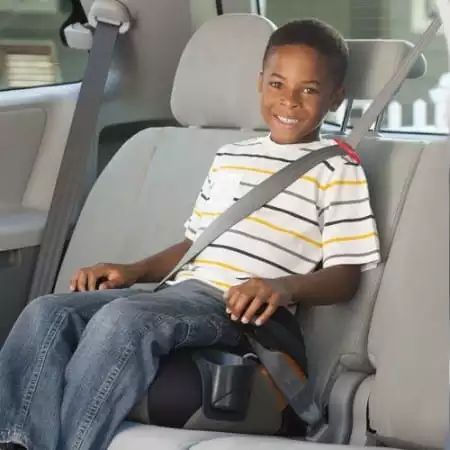
Picture credit: Amazon
We evaluated car seats with hands on inspections, checking seats for ease of use (installation and adjusting the seat). We also gather significant reader feedback, tracking seats on quality and durability. Besides interviewing parents, we also talk with car seat “techs,” certified child passenger safety technicians who install hundreds if not thousands of seats at safety check points nationwide.
We’ve been rating and reviewing car seats since 1994. During that time, we have also visited manufacturer facilities and watched car seat crash tests. While we don’t personally crash test seats, we compare our reader feedback with crash tests done by organizations like the National Highway Traffic Safety Administration and Consumer Reports. We also look at third-party evaluations of seats by groups like the Insurance Institute for Highway Safety (IIHS), which focuses on booster car seats.
7 Things No One Tells You About Buying a Booster Car Seat!
1. Booster seats come in four different flavors:
◆ High back boosters (HBB): Belt-positioning boosters come in two flavors: high back boosters and backless boosters. High back boosters have often been called “kid’s captain’s chairs,” which they kind of resemble. They are designed to be simple, but provide vital safety features for children who’ve outgrown a harnessed seats. These boosters properly position the lap belt on a child’s strong hip bones, rather than letting it ride up on the soft internal organs. And they provide correct positioning of the shoulder belt, so the child can comfortably wear it and get critical upper body support. The high back also protects the child’s head from whiplash if there are no head restraints in the vehicle, and the high back may also give some side sleeping support. ALL of these boosters require a lap and shoulder belt. FYI: Some high back boosters convert into backless boosters for older kids.
◆ Backless boosters: These belt-positioning boosters work the same way as high back boosters—they just don’t have a back. Safety-wise, these can be a bit better than a high back booster, since the child sits against the vehicle seat. They do the same job positioning the lap belt, and usually include some sort of strap to adjust the shoulder belt. But they don’t provide head support if you have low seat backs, and they don’t give any side or sleeping support. On the other hand, they are often popular with older kids, since they can be quite inconspicuous.
◆ Harnessed boosters: These are probably the most confusing “booster” seats because they sometimes morph from a forward-facing harnessed seat to a belt-positioning booster (and in some case) to a backless booster. With the five-point harness, boosters can generally be used up to 65, 80 or 90 lbs. Then the harness is removed, and the seat can be used as a belt-positioning booster, usually to 80 or 100 lbs. These seat also may be referred to as “combination,” or “combo” for short, from the two jobs they do. Our top recommendation on this page is for a harnessed booster.
The take-home message: we recommend a harnessed booster as the safest option to transport a toddler. Keep your child in the harness as long as possible (given seat weight and height limits).
◆ Special Needs Seats: There are a few seats on the market now that don’t really fit into any category. One is the Britax Traveler Plus, which is designed for special needs kids up to 105 lbs.
2. When is your child ready for the auto safety belt?
Some states allow children as young as six to legally ride in an auto safety belt (that is, booster seat use isn’t required). But there is the law—and the law of physics. Numerous peer-reviewed safety studies show that continued booster seat use is the safest course . . . until a child can SAFELY use an auto safety belt. When is that?
When a child is over 4’9” and can sit with his or her back straight against the back seat cushion (with knees bent over the seat’s edge), then he or she can go with just the auto’s safety belt. Still have doubts?
Try this Five-Step Test from Safety Belt Safe, USA:
1. Does the child sit all the way back against the auto seat?
2. Do the child’s knees bend comfortably at the edge of the seat?
3. Does the belt cross the shoulder between neck and arm?
4. Is the lap belt as low as possible, touching the thighs?
5. Can the child stay seated like this for the whole trip?
If you answered no to any of these questions, your child needs a booster seat, and will probably be more comfortable in one too.
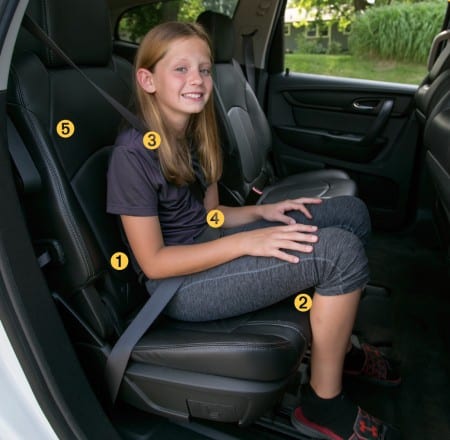
This child passes the 5-step test. Photo credit: uwhealth.org
3. Using a booster seat too soon can be dangerous.
You’ll note that some harnessed boosters have starting weight limits as young as 20 lbs.—that could be as young as a six month aged baby. But remember this: all boosters are forward-facing. And the current recommendation by safety experts is to keep your child REAR-FACING until age 2 or longer. So even though you could use a forward-facing harnessed booster for a one year old, we wouldn’t recommend it.
Also: don’t abandon the harness too soon. Yes, you could switch to a belt-positioning booster as soon as four years (or 40 lbs.). Our advice: don’t. Keep your child in that harness as long as you can (that’s why our top recommended seats on this page have top harness limits of 80 and 90 lbs.).
4. Your car’s owner’s manual is an important resource.
Sure, you probably haven’t look at it since you purchased the vehicle. But most auto manuals have detailed advice about car seat use. And that comes in especially handy when you start using a booster. That’s because some boosters can use LATCH—but your vehicle may prohibit this use when the weight of your seat plus your child exceed a certain limit.
5. Sitting in a belt-positioning booster requires maturity.
Yes, we recommend using a harness as long as possible—but we are also the parents of two kids. And we remember the pleas from a toddler who didn’t want to sit in a “baby seat” (that is, the harness). The challenge: to use a belt-positioning booster, a child must be mature enough to understand the iron clad rule: you NEVER wiggle out from under the belt when the car is in motion. Some kids are ready for this and others need more time in a harness!
6. Only use cardboard cups in booster seat cup holders.
You’ll note that many booster seats come with cup or juice box holders. These are a great convenience, but most car seat makers only recommend putting cardboard cups or juice boxes in these holders. Why? In a collision anything heavier than a cardboard juice box or cup can become a dangerous projectile.
7. There isn’t one national standard for how long your child should be in a booster seat.
Booster seat use is regulated on a state-by-state basis, at least when we’re talking about how long kids must remain in a booster. Some states have an age limit, some a weight and/or height limit. If you’re unsure about the rules in your state, check your state Department of Motor Vehicles’ web site.
Safety Alert
Certifications to look for when booster car seat shopping
NHTSA Ease of Use Rating: The National Highway Transportation Safety Administration (NHTS) publishes Ease-of-Use Ratings that cover four areas:
- Evaluation of Instructions: Content and clarity of the instructions manual for the child restraint.
- Vehicle Installation Features: Features that pertain to installing the child restraint in a vehicle.
- Evaluation of Labels: Content and clarity of the labeling attached to the child restraint.
- Securing the Child: Ease in securing a child correctly in the restraint.
Seats are ranked on a one to five star scale.
Insurance Institute for Highway Safety (IIHS) uses a six-year-old dummy to check the lap and shoulder belt fit of booster seats. Seats are award ratings of Best Bet, Good Bet and Check Fit. The last rating doesn’t mean a seat has failed, but requires a parent to double check fit in their own vehicle.
And yes, there are a few seats that are “not recommended.”
Here’s how the IIHS looks at booster seat fit:

BabyBargains.com is a participant in the Amazon Services LLC Associates Program, an affiliate advertising program designed to provide a means for sites to earn advertising fees by advertising and linking to Amazon.com and its related sites. As an Amazon Associate, I earn from qualifying purchases.


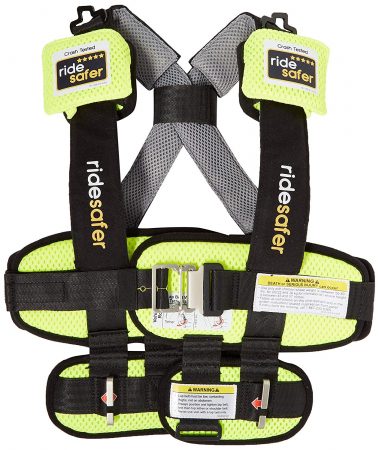

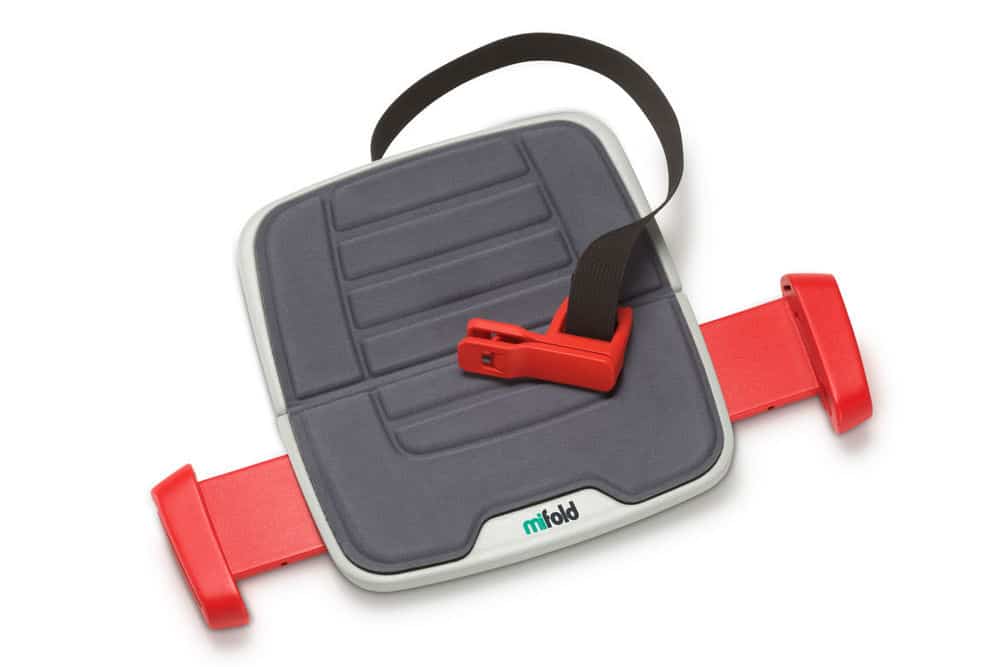
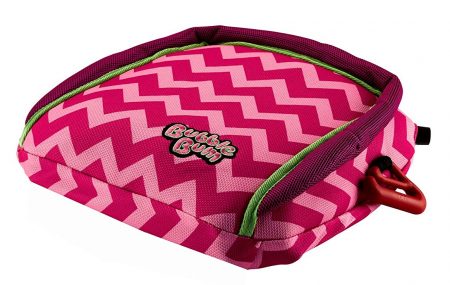
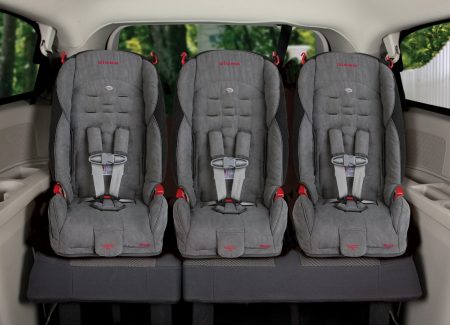
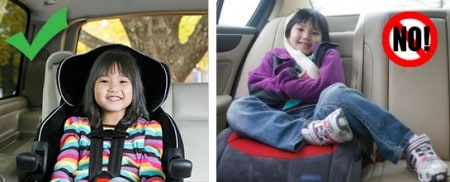
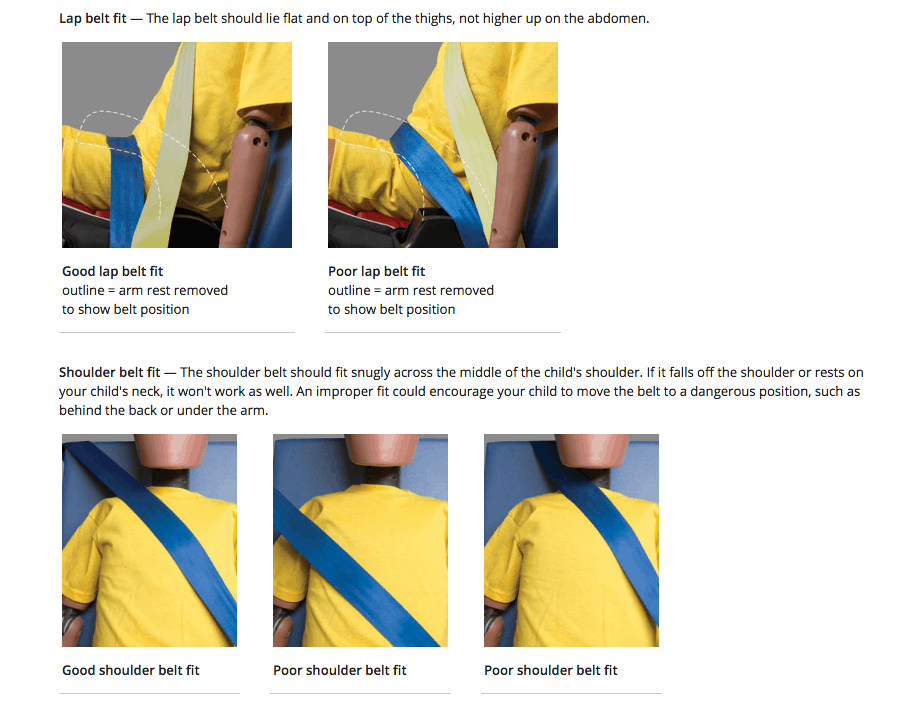
 We obsess over gear for families and the home . . . so you don’t have to. Baby Bargains has one mission: help you find the best gear for your family with unbiased reviews by experts with 20 years of experience. At prices that don’t break the bank. When you purchase a product from links on this site, we make a small affiliate commission. Learn more
We obsess over gear for families and the home . . . so you don’t have to. Baby Bargains has one mission: help you find the best gear for your family with unbiased reviews by experts with 20 years of experience. At prices that don’t break the bank. When you purchase a product from links on this site, we make a small affiliate commission. Learn more 
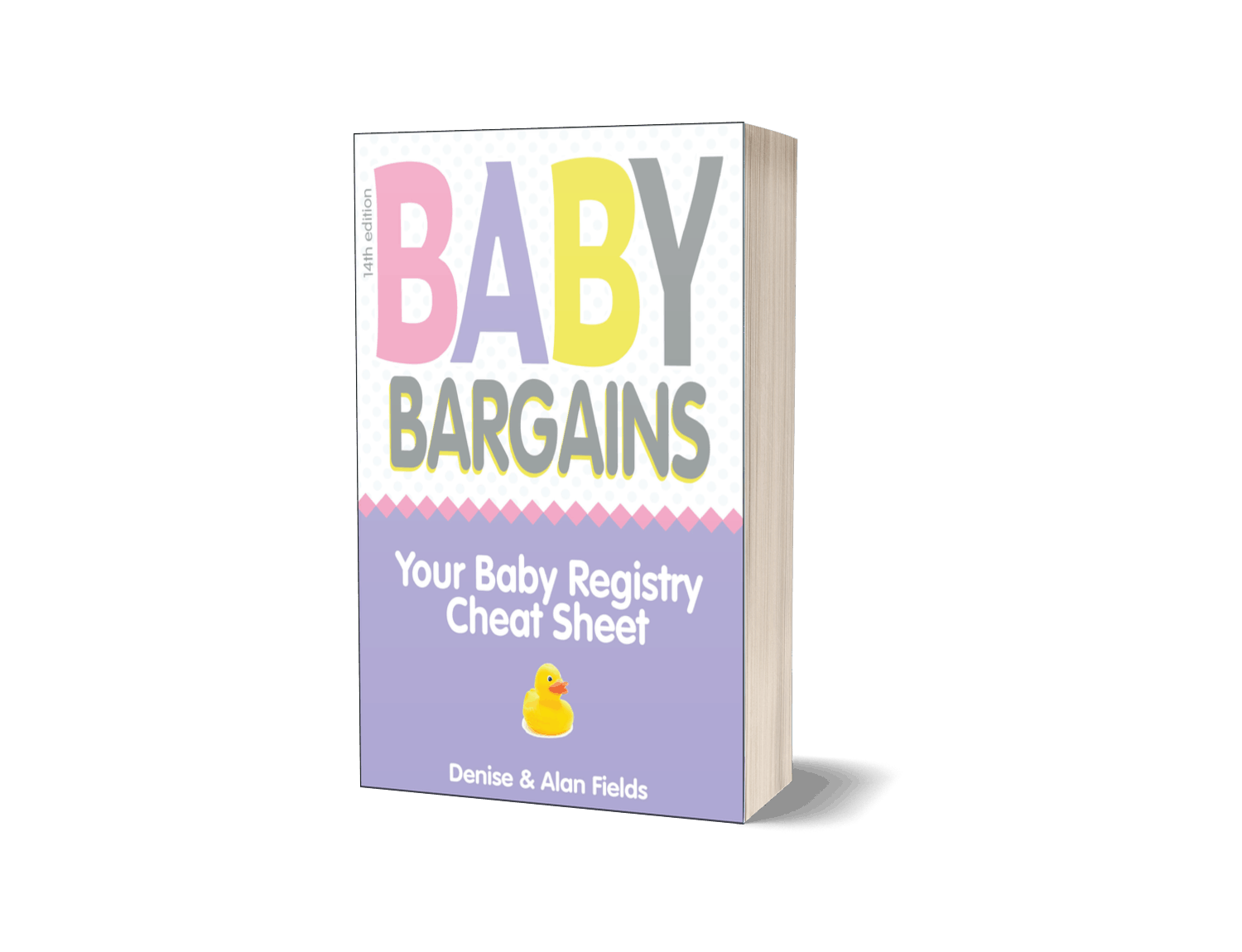
I want to share my experience that the Chicco Keyfit 30 is an excellent car seat, but that to be safely installed with the base in my Mazda sedan it cannot be placed in the center seat. To be in the center seat, it must be installed without the base using the seat belt. That’s not a dealbreaker for me, but for parents planning to carpool, it is worth keeping this in mind so you can plan accordingly. Center seat depths seem to vary by car manufacturer, so you might want to check this out before you commit to purchase.
Thanks for writing in LW! Good point—getting any seat to fit three across will depend on that center position and whether you can put a car seat there. And that can vary by vehicle, unfortunately! Thanks again for writing in!